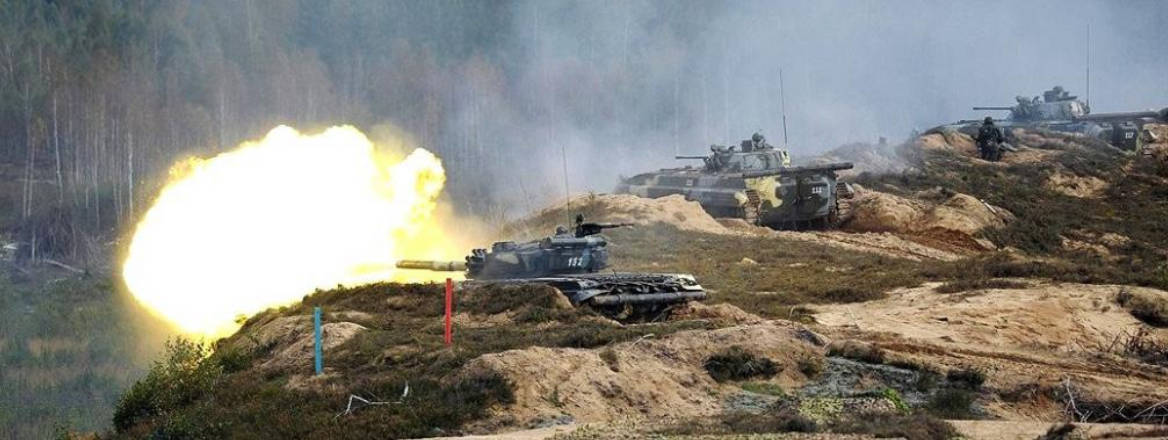Russia’s declared number of troops taking part in the biannual Zapad-2017 military exercise, about to start in Belarus, reveals that Moscow is almost certainly being ‘economical with the truth’.
The week-long Zapad-2017 (West-2017) Russian–Belarussian joint strategic exercises starting on Thursday has caused a great deal of tension in NATO member states and Russia’s other European neighbours. Top of the concerns is the number of troops participating in the exercise.
Explaining this rather obsessive attention to numbers is easy. Under Article 47.4 of the OSCE’s 2011 Vienna Document, signatories – including Russia – are obliged to invite foreign observers to monitor their military drills if more than 13,000 troops are involved.
To avoid foreign monitoring of its exercises, Russia and Belarus announced that just 12,700 troops will be participating in the exercise, below the Vienna Document threshold.
That figure has been vigorously contested by other European states, with the Polish General Staff estimating that around 100,000 Russian troops have been mobilised. Lithuania and Ukraine have put the figure considerably higher, with the former claiming 140,000 troops and the latter 240,000.
A forensic analysis of the data available about these exercises, including that related to mandatory reporting of the military equipment restricted by the Conventional Forces in Europe (CFE) Treaty, offers conclusive evidence that Russia is being economical with the truth. This analysis suggests the number of troops participating in the exercises will be closer to 65–70,000.
According to Russia’s own CFE-related notifications, it is clear that 150 artillery pieces (APs), 140 main battle tanks (MBTs) and 230 armoured combat vehicles (ACVs) will be involved in Zapad-2017.
This accurately corresponds to the combined forces of one Belarussian motorised-rifle brigade (40 MBTs, 180 ACVs, 78 APs and 4,900 men) and one Russian tank brigade (94 MBTs, 61 ACVs, 44 APs, 2,900 troops).
In addition, it includes a detached battalion of artillery (18 APs, around 200 men) and support elements (around 2,000 troops, including the 86th Communications Brigade, with limited amounts of CFE-restricted equipment) of the Belarussian armed forces.
It is also known that the 6th Tank Brigade of the Russian 1st Guards Tank Army (TA) deployed to Belarus for the Zapad-2017 exercises, which confirms the above analysis. The Russian General Staff’s 70th Mobile Command Post has reportedly also arrived in Belarus for the exercises.
However, the inconsistencies emerge in the part of the exercises on Russian territory, where it is claimed 2,500 troops with 110 MBTs, 200 ACVs and 50 APs will take part. This corresponds to the combined force of one tank regiment and one motorised-rifle regiment, with the addition of a detached reconnaissance battalion, which includes 125 MBTs, 201 ACVs and 52 APs.
Some additional minor details allow us to conclude that these are the 1st Tank Regiment (1,950 men), 1st Guards Motorised-Rifle Regiment (2,525 men), and the 136th Detached Guards Reconnaissance Battalion (236 men) of the 2nd Guards ‘Tamanskaya’ Motorised-Rifle Division of the 1st Guards TA.
It is therefore clear that the cumulative number of personnel openly participating in the exercise on Russian territory is higher than announced – around 4,700 instead of the claimed 2,500 men. This puts the actual cumulative number of the troops openly involved in Zapad-2017 at 14,900 at least, above the Vienna Document threshold.
Meanwhile, there is a substantially larger number of Russian troops taking part in the exercise in Belarus: there is evidence that the whole 4th Guards ‘Kantemirovskaya’ Tank Division (approximately 9,600 men) is being deployed to Belarus, alongside some other – still unidentified – formations.
Indeed, the Russian Ministry of Defence requested the use of 4,162 train carriages to transport its military equipment to Belarus, specifically mentioning that all those carriages were return services.
This represents a massive increase on the 2015 and 2016 transport requirement, which were 125 and 50 carriages respectively, a rise in requirements which one can only assume as necessary to fulfilling the day-to-day needs of the Russian forces permanently deployed to Belarus.
Still, this leaves approximately 4,000 currently contracted train carriages to deliver Russian forces to Belarus for exercises and then withdraw them. We know that approximately 250 carriages were already used earlier this year to transport elements of the Russian rear and support elements, with the stated goal of preparing the infrastructure for Zapad-2017, although the transportation of the 6th Tank Brigade alone takes 734 carriages.
Bearing in mind that the transportation of the ‘Kantemirovskaya’ Division takes 2,180 carriages one way, which leaves approximately 850 carriages to deploy 1,500–5,000 more troops, depending on the type of units/formations in Belarus. (The lower estimate corresponds only with deployment of the personnel-light, equipment-heavy combat engineer units.)
Meanwhile, in addition, Zapad-2017 includes formations of the Russian 11th and 14th Army Corps, as well as the Russian Airborne Troops, taking part unannounced. These formations number around 41,000 troops, taking the cumulative count of troops involved to 65–70,000 – considerably higher than the Vienna requirements.
The reasons for inclusion of other, unannounced, Russian troops in the total count of the Zapad-2017 exercises will be discussed in the second part of this analysis.
The views expressed in this Commentary are those of the author, and do not reflect those of RUSI or any other institution.
Russia's New Ground Forces: Capabilities, Limitations and Implications for International SecurityThis Whitehall Paper provides an in-depth analysis of Russia’s Ground Forces, including airborne and naval troops Access the Whitehall Paper |


